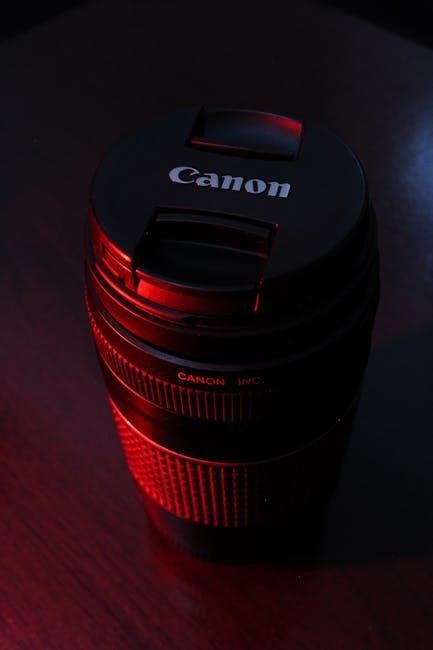Welcome to the Canon EOS 7D manual, your comprehensive guide to mastering this powerful DSLR camera. Discover its 18MP sensor, Dual DIGIC 4 processors, and advanced features for optimal photography.
Overview of the Canon EOS 7D Camera
The Canon EOS 7D is a high-performance DSLR camera designed for enthusiasts and professionals. It features an 18.0-megapixel CMOS sensor, Dual DIGIC 4 image processors, and a 19-point cross-type AF system for precise focusing. With 8 frames per second continuous shooting and full HD movie recording, the 7D excels in dynamic photography and videography. Its robust build and intuitive controls make it ideal for capturing high-quality images in various shooting conditions, ensuring versatility and reliability for creative and demanding projects.
Importance of the Manual for Optimal Camera Usage
The Canon EOS 7D manual is essential for unlocking the camera’s full potential. It provides detailed guidance on mastering advanced features, customizing settings, and troubleshooting common issues. Whether you’re a novice or an experienced photographer, the manual ensures you understand the camera’s capabilities and optimize its performance. Available as a downloadable PDF, it offers convenient access to comprehensive instructions, enabling you to enhance your photography skills and maintain your camera effectively for years of reliable use and creative excellence.
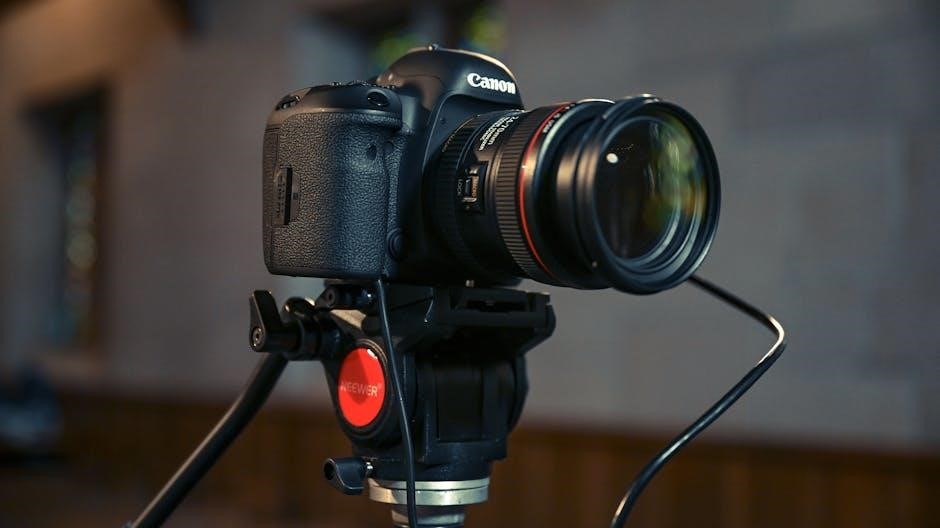
Key Features of the Canon EOS 7D
The Canon EOS 7D boasts an 18.0 MP CMOS sensor, Dual DIGIC 4 processors, 19-point AF, 8 fps shooting, and Full HD video capabilities for exceptional image and video quality.
18.0 Megapixel CMOS Sensor
The Canon EOS 7D features a high-resolution 18.0 Megapixel CMOS sensor, capturing detailed images with excellent clarity and color accuracy. This sensor ensures optimal performance in various lighting conditions, producing vibrant and sharp results. Its advanced design allows for high sensitivity, reducing noise and enabling better low-light photography. The large pixel size enhances dynamic range, making it ideal for both professional and enthusiast photographers seeking high-quality output consistently.
Dual DIGIC 4 Image Processors
The Canon EOS 7D is equipped with Dual DIGIC 4 Image Processors, enhancing image processing speed and quality. These processors enable advanced noise reduction, improved color accuracy, and faster autofocus performance. They also support high-speed continuous shooting at up to 8 frames per second. The dual processing power ensures efficient handling of complex tasks, delivering sharp, detailed images with minimal lag, making it ideal for capturing dynamic scenes and ensuring optimal performance in various shooting conditions.
19-Point Autofocus System
The Canon EOS 7D features a high-precision 19-point autofocus system, all of which are cross-type for enhanced accuracy. This advanced system provides wide coverage and exceptional performance in various lighting conditions, including low light. The 19-point AF ensures quick and precise focus acquisition, making it ideal for dynamic subjects and fast-moving objects. Users can select individual points or groups, allowing for greater control over focus placement. This robust autofocus system is a key feature for capturing sharp images consistently in challenging shooting scenarios.
8 Frames Per Second Continuous Shooting
The Canon EOS 7D offers an impressive 8 frames per second continuous shooting mode, enabling photographers to capture high-speed action with precision. This feature is ideal for sports, wildlife, and dynamic scenes, allowing users to freeze fleeting moments effortlessly. The rapid burst mode ensures minimal delay between shots, making it easier to track fast-moving subjects and capture sharp, well-timed images consistently. This capability enhances the camera’s versatility for professionals and enthusiasts alike, delivering exceptional performance in demanding shooting environments.
Live View and Full HD Movie Shooting
The Canon EOS 7D features Live View technology, allowing precise composition and focusing via the LCD screen. It also supports Full HD movie shooting at 1080p resolution, capturing cinematic-quality video with manual controls for exposure, aperture, and frame rates. This versatility makes it ideal for photographers transitioning to videography, offering creative freedom and professional-grade output in both stills and motion. The camera’s dual memory card slots also ensure ample storage for extended video recording sessions.
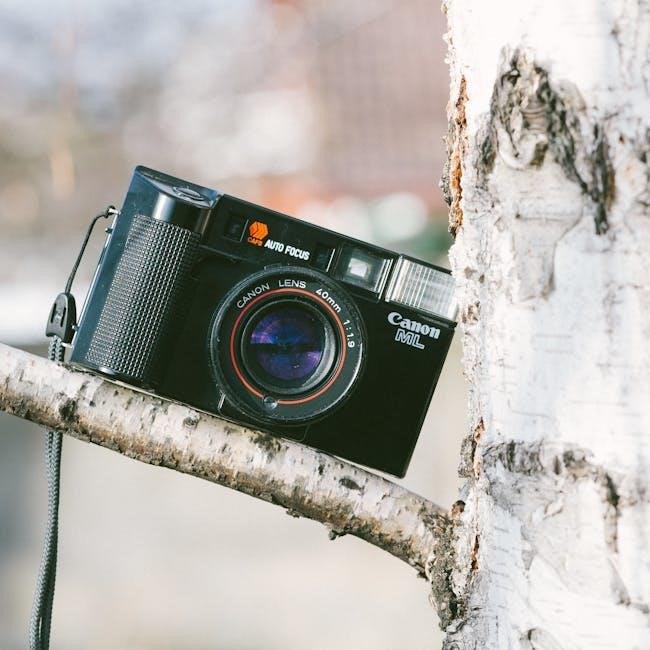
Understanding the Manual Structure
The EOS 7D manual is structured for easy navigation. The table of contents and quick reference guide help users find information quickly, ensuring efficient learning and use.
Table of Contents and Navigation
The EOS 7D manual begins with a detailed table of contents, organizing chapters logically. Each section is clearly labeled, allowing users to navigate seamlessly through topics like camera setup, shooting modes, and maintenance. The index provides quick access to specific features, enhancing usability. This structured approach ensures that photographers of all levels can efficiently find the information they need to optimize their camera’s performance and unlock its full potential.
Quick Reference Guide vs. Detailed Manual
The EOS 7D manual offers two options: a Quick Reference Guide and a Detailed Manual. The Quick Reference provides a concise overview of basic operations, ideal for beginners. The Detailed Manual covers advanced features, customization, and troubleshooting in depth. Both are available in PDF format, ensuring easy access. Use Adobe Reader for optimal viewing. This dual approach caters to all skill levels, helping users master the camera’s capabilities efficiently. Choose the guide that best suits your needs for a tailored learning experience.
Downloading and Accessing the PDF Manual
The Canon EOS 7D manual is available as a downloadable PDF file, ensuring easy access to detailed instructions. Visit the official Canon website or authorized sources to find the manual. Click the download link, save the file, and open it using Adobe Reader or a compatible PDF viewer; The manual is divided into sections for quick navigation, covering setup, features, and troubleshooting. Ensure your device has the latest PDF reader for optimal viewing. This convenient format allows you to access guidance anytime, anywhere.

Camera Setup and Initial Configuration
Configure your Canon EOS 7D with ease by following the initial setup guide. Customize settings, update firmware, and personalize preferences for enhanced photography experiences.
First-Time Setup and Initialization
Begin by charging the battery and inserting a memory card. Power on the camera and select your language, date, and time. Set the time zone and adjust for daylight saving time if necessary. Choose the appropriate image quality and autofocus options based on your preferences. Familiarize yourself with the camera’s controls and customize settings to suit your shooting style. Refer to the manual for detailed guidance on initial configuration and optimization.
Customizing Camera Settings
Customize the EOS 7D to your preferences by adjusting shooting modes, autofocus options, and exposure settings. Personalize button functions and dial controls for intuitive operation. Use the menu system to tailor settings like ISO sensitivity, white balance, and metering modes. Save frequently used configurations in custom shooting modes (C1-C3) for quick access; Explore advanced features such as custom functions to fine-tune camera behavior and optimize performance for specific photography styles or scenarios.
Updating Firmware and Software
Keep your EOS 7D up-to-date by regularly updating its firmware and software. Visit Canon’s official website to download the latest firmware version and follow the installation instructions in the PDF manual. Ensure improved camera performance, enhanced features, and compatibility with the latest accessories. Use the provided USB connection for a secure update process. Always verify the firmware version in the camera’s menu before updating to avoid unnecessary installations. This ensures optimal functionality and access to the latest advancements in camera technology.
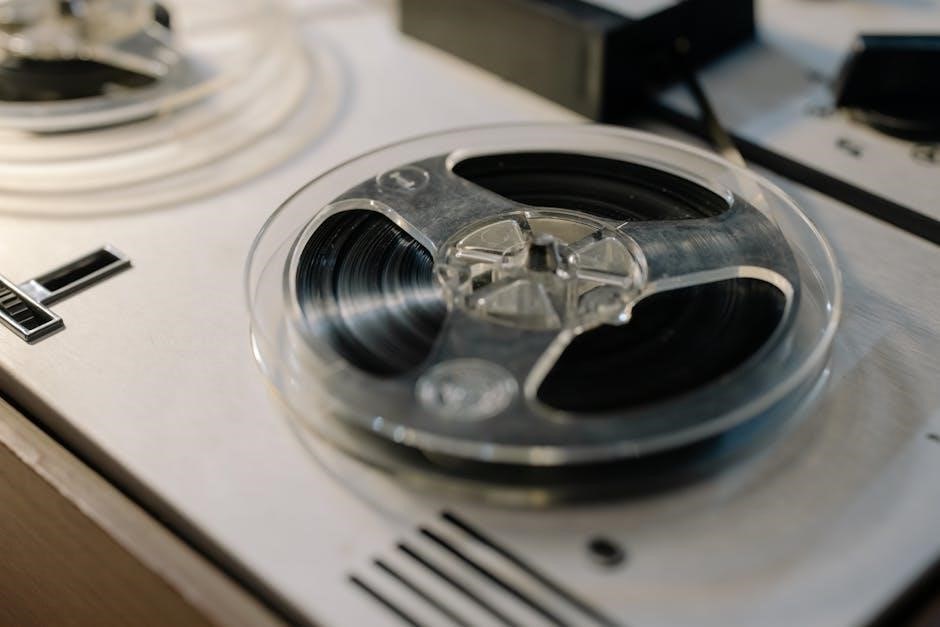
Autofocus and Metering Modes
Explore the EOS 7D’s advanced autofocus and metering systems, designed for precise control over focus and exposure, ensuring sharp images and accurate light measurement in various conditions.
19-Point Cross-Type Autofocus System
The Canon EOS 7D features a high-precision 19-point cross-type autofocus system, ensuring rapid and accurate focus acquisition. The cross-type sensors provide superior performance, especially in low-light conditions, by detecting both horizontal and vertical detail. This advanced system allows for effective subject tracking, even with moving objects, making it ideal for sports and wildlife photography. The AF points are strategically arranged across the frame, enabling wide-area coverage and precise control over focus placement, ensuring sharp images in various shooting scenarios.
Understanding Metering Modes
The Canon EOS 7D offers four metering modes to ensure accurate exposure: Evaluative, Center-Weighted, Spot, and Partial. Evaluative metering analyzes the entire scene, prioritizing subject brightness. Center-Weighted emphasizes the center area, ideal for portraits. Spot metering measures a specific point, useful for high-contrast scenes. Partial metering covers a larger spot area than Spot mode. These modes adapt to various lighting conditions, allowing precise control over exposure settings for professional-grade photography results.
AF Point Selection and Customization
The Canon EOS 7D features a 19-point cross-type AF system, allowing precise focus selection. Users can manually select AF points using the Multi-controller or Main Dial, ensuring sharp focus on desired subjects. Customization options include registering favorite AF points for quick access and adjusting AF tracking sensitivity to suit different shooting scenarios. This level of control enhances flexibility and accuracy, making it ideal for dynamic photography situations. The camera’s adaptability ensures optimal performance in various lighting and compositional challenges, catering to both professionals and enthusiasts. Customizing AF points streamlines workflows, allowing photographers to focus on creativity seamlessly.
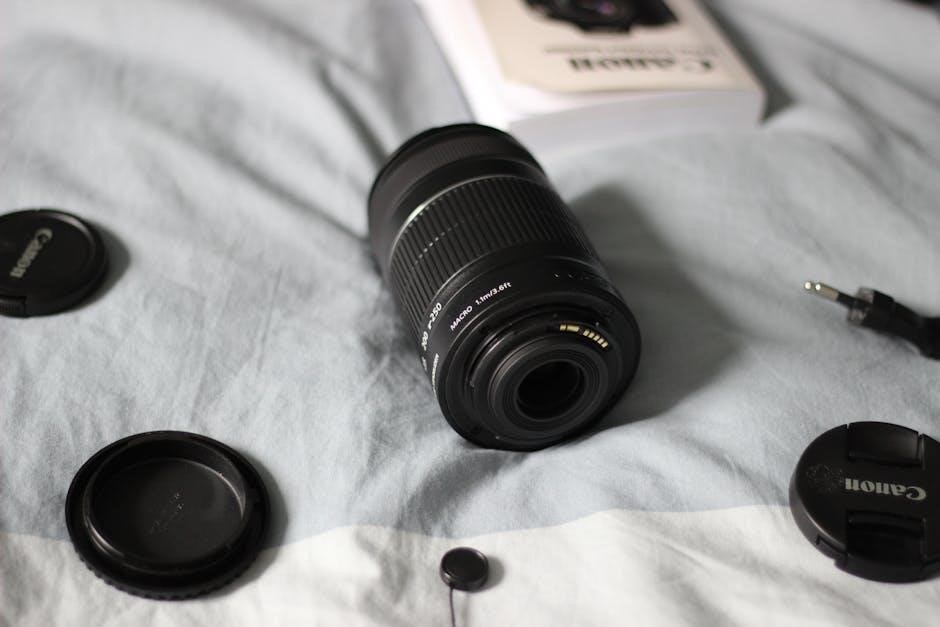
Shooting Modes and Techniques
The Canon EOS 7D offers versatile shooting modes, including Scene Modes, Creative Auto, Manual, Aperture Priority, and Shutter Priority. Burst Mode and Silent Shooting enhance flexibility for diverse photography needs.
Scene Modes and Creative Auto
The Canon EOS 7D offers Scene Modes and Creative Auto for simplified shooting. Scene Modes optimize settings for specific scenarios like portraits, landscapes, and sports. Creative Auto provides user-friendly adjustments for aperture, ISO, and color balance while maintaining automatic control. These modes are ideal for photographers seeking professional results without manual adjustments, allowing for creative freedom and ease of use in various lighting conditions and subjects.
Manual, Aperture Priority, and Shutter Priority Modes
The Canon EOS 7D offers Manual (M), Aperture Priority (Av), and Shutter Priority (Tv) modes for advanced control. Manual Mode allows full control over aperture and shutter speed for precise adjustments. Aperture Priority lets you set the aperture, with the camera adjusting shutter speed for exposure. Shutter Priority enables setting shutter speed to capture motion effects, with the camera adjusting aperture. These modes provide flexibility for photographers to achieve desired effects in various lighting conditions and subjects.
Burst Mode and Silent Shooting
Burst Mode on the Canon EOS 7D allows continuous shooting at up to 8 frames per second, ideal for capturing fast-moving subjects. Silent Shooting reduces operational noise, making it perfect for discrete photography. Both modes enhance versatility, enabling photographers to adapt to dynamic situations. Use Burst Mode for action shots and Silent Shooting for quiet environments, ensuring you never miss a moment. These features make the EOS 7D a versatile tool for diverse photography needs.
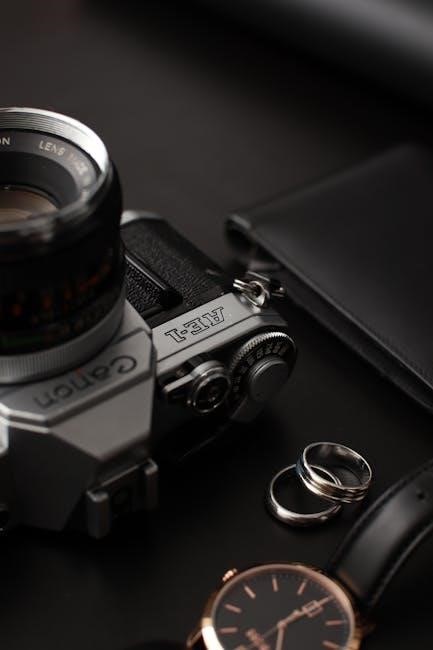
Custom Functions and Personalization
The Canon EOS 7D offers extensive customization options, allowing users to tailor settings and functions to their preferences. Personalize your shooting experience with custom functions, button assignments, and My Menu for streamlined workflow and enhanced control.
Configuring Custom Functions
The Canon EOS 7D allows users to configure custom functions to tailor camera settings to their preferences. Through the menu system, you can adjust options like autofocus behavior, metering modes, and exposure adjustments. These customizations enable personalized control over shooting parameters, enhancing efficiency and creativity. The camera provides multiple custom function groups, each assignable to specific buttons or dials, ensuring quick access to frequently used settings. This feature is particularly useful for professional photographers seeking streamlined workflows and precise control over their equipment.
Assigning Buttons and Dial Functions
The Canon EOS 7D allows users to assign custom functions to specific buttons and dials, enhancing operational efficiency. Buttons like the AF-ON or depth-of-field preview can be reassigned to suit individual preferences. The Quick Control Dial and Main Dial can also be customized for ISO, AF mode, or exposure compensation. This feature enables photographers to tailor the camera’s controls to their workflow, ensuring quick access to frequently used settings during shoots.
My Menu Setup for Quick Access
The Canon EOS 7D’s My Menu feature allows users to create a personalized menu of frequently used settings for quick access. This customization simplifies workflow by grouping essential functions like ISO, AF modes, and image quality. To set up My Menu, navigate to the camera’s menu, select “My Menu,” and register your preferred settings. Organize them logically to streamline operations during shoots, ensuring efficiency and reducing time spent navigating through multiple menus.

Video Shooting and Live View
The Canon EOS 7D excels in video shooting with Full HD recording and Live View functionality. It offers manual controls for precise adjustments during filming, ensuring high-quality output.
Full HD Movie Recording
The Canon EOS 7D supports Full HD movie recording at 1080p resolution, capturing vivid details and colors. With manual controls, users can adjust settings like aperture, shutter speed, and ISO during filming. The camera also features a dedicated movie mode for seamless transition from still photography to video. Additionally, the EOS 7D allows for external microphone input, enhancing audio quality. This feature makes it ideal for professional and enthusiast filmmakers seeking high-quality video output.

Live View Shooting and Focusing
Live View on the Canon EOS 7D allows for real-time preview of your shots on the LCD screen, enabling precise composition and focus control. This feature is particularly useful for macro, low-angle, or high-angle photography. The camera offers multiple focusing modes in Live View, including Quick Mode, Live Mode, and Face Detection, ensuring sharp images. With the 19-point AF system, focusing is fast and accurate, even in challenging conditions. Live View also supports manual focus for creative control, making it ideal for both still photography and movie recording.
Video Autofocus and Stabilization
The Canon EOS 7D supports advanced video autofocus and stabilization, ensuring smooth and sharp footage. During movie recording, the camera offers continuous AF with subject tracking, reducing focus hunting. Optical Image Stabilizer in compatible EF and EF-S lenses minimizes camera shake, enhancing video clarity. The Dual DIGIC 4 processors optimize autofocus speed and accuracy, while Face Detection ensures precise tracking of subjects. These features make the EOS 7D ideal for capturing high-quality, professional-looking video content with ease and precision.
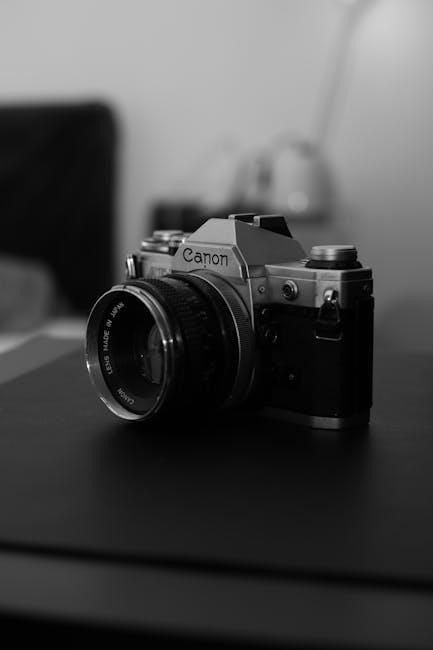
Camera Maintenance and Troubleshooting
Regularly clean the sensor and lens to prevent dust and smudges. Update firmware for optimal performance and troubleshoot common issues like error codes or autofocus malfunctions promptly.
Cleaning the Sensor and Lens
Regularly clean the EOS 7D’s sensor and lens to ensure optimal image quality. Use a soft-bristled brush or compressed air to remove dust. For stubborn smudges, use a microfiber cloth with a cleaning solution. Avoid touching the lens surface to prevent fingerprints. Clean the sensor in a dust-free environment, using the camera’s built-in cleaning mode. Refer to the manual for detailed cleaning instructions and recommended tools. If unsure, consult a professional to avoid damage. Regular maintenance ensures sharp, clear photos every time.
Common Issues and Solutions
Troubleshoot common EOS 7D issues with ease. If the camera won’t turn on, check the battery or power source. For blurry images, ensure autofocus is functioning and the lens is clean. Memory card errors may require formatting or replacement. If the camera freezes, restart it or update firmware. Consult the manual for solutions to error messages or unexpected behavior. Regular updates and proper maintenance can prevent many issues, ensuring smooth operation and high-quality results. Contact Canon support if problems persist.
When to Contact Canon Support
Contact Canon Support for complex issues or persistent problems. If the camera malfunctions despite troubleshooting, or if there’s physical damage, reach out. For firmware update failures or severe software glitches, professional assistance is recommended. Issues like water damage or hardware defects require immediate attention. Visit Canon’s official website for support resources, or call their customer service for personalized help. Ensure your device is serviced by authorized professionals to maintain its performance and warranty.
Mastering the Canon EOS 7D requires practice and exploration of its advanced features. For further learning, visit Canon’s official website for downloadable manuals, firmware updates, and tutorials. Explore additional resources like the “EOS 7D Mark II For Dummies” or online forums for tips and troubleshooting. Stay updated with the latest software and guides to maximize your camera’s potential and enhance your photography skills.
Final Tips for Mastering the EOS 7D
Experiment with various shooting modes and autofocus settings to optimize your photography. Regularly update firmware for improved performance. Customize buttons and settings to suit your workflow. Practice using manual controls for creative results. Utilize Canon’s official resources and online communities for troubleshooting and inspiration. Explore advanced techniques like burst mode and silent shooting for dynamic captures. Keep the manual handy for quick reference and dive into tutorials for mastering video recording and Live View functionality.
Recommended Reading and Online Resources
Visit Canon’s official website for the EOS 7D manual and software updates. Explore forums like Canon Rumors and Digital Photography School for tips and troubleshooting. Check out books like “Canon EOS 7D For Dummies” for in-depth guidance. Utilize YouTube tutorials for hands-on learning. Subscribe to photography blogs for the latest techniques and gear reviews. Access PDF guides from trusted sources to enhance your mastery of the EOS 7D’s features and capabilities.
